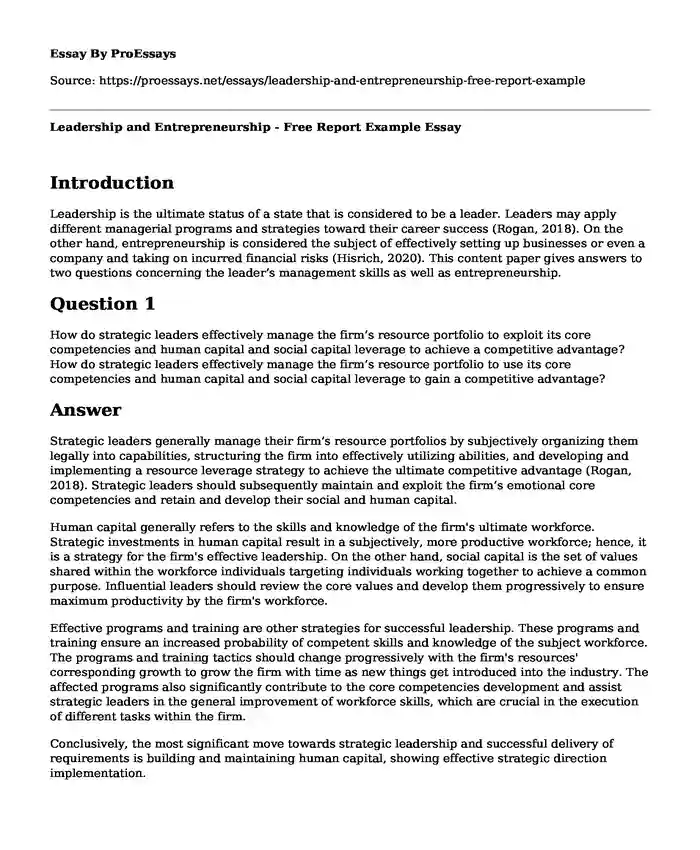Introduction
Leadership is the ultimate status of a state that is considered to be a leader. Leaders may apply different managerial programs and strategies toward their career success (Rogan, 2018). On the other hand, entrepreneurship is considered the subject of effectively setting up businesses or even a company and taking on incurred financial risks (Hisrich, 2020). This content paper gives answers to two questions concerning the leader’s management skills as well as entrepreneurship.
Question 1
How do strategic leaders effectively manage the firm’s resource portfolio to exploit its core competencies and human capital and social capital leverage to achieve a competitive advantage? How do strategic leaders effectively manage the firm’s resource portfolio to use its core competencies and human capital and social capital leverage to gain a competitive advantage?
Answer
Strategic leaders generally manage their firm’s resource portfolios by subjectively organizing them legally into capabilities, structuring the firm into effectively utilizing abilities, and developing and implementing a resource leverage strategy to achieve the ultimate competitive advantage (Rogan, 2018). Strategic leaders should subsequently maintain and exploit the firm’s emotional core competencies and retain and develop their social and human capital.
Human capital generally refers to the skills and knowledge of the firm's ultimate workforce. Strategic investments in human capital result in a subjectively, more productive workforce; hence, it is a strategy for the firm's effective leadership. On the other hand, social capital is the set of values shared within the workforce individuals targeting individuals working together to achieve a common purpose. Influential leaders should review the core values and develop them progressively to ensure maximum productivity by the firm's workforce.
Effective programs and training are other strategies for successful leadership. These programs and training ensure an increased probability of competent skills and knowledge of the subject workforce. The programs and training tactics should change progressively with the firm's resources' corresponding growth to grow the firm with time as new things get introduced into the industry. The affected programs also significantly contribute to the core competencies development and assist strategic leaders in the general improvement of workforce skills, which are crucial in the execution of different tasks within the firm.
Conclusively, the most significant move towards strategic leadership and successful delivery of requirements is building and maintaining human capital, showing effective strategic direction implementation.
Question 2
How does strategic entrepreneurship help firms create value, and what kinds of leadership strategies would be pertinent to you, as a potential individual competitor and entrepreneur? In other words, can you identify your "go-to" leadership style or styles?
Answer
Strategic entrepreneurship should effectively implement strategic leadership dimensions to maximize the utilization of skills within the firm (Hisrich, 2020). The practical leadership dimensions come as entrepreneurship characteristics, which are:
- Strategic entrepreneurs should portray their unconditional ability to thrive in subjective uncertainty successfully. This ability ensures significant productivity within conditional environments. The entrepreneur uses different strategies to concur with the environmental challenges and ensure maximum productivity in the firm.
- Strategic entrepreneurs should also show that passionate personal desire to own and author the project. This desire ensures a personal responsibility taken by the entrepreneur to achieve the project's success, resulting in maximum productivity and accountability.
- Strategic entrepreneurs should subsequently have a unique persuasion skill. This persuasion skill is a crucial mover towards effective negotiations that improve the firm's productivity and activity.
I would recommend the autocratic leadership style. This leadership style is the leadership style that is generally '' do as I say". Since there are leaders and entrepreneurs responsible for steering the firm, most decisions are considered to be strategic decisions personally made by the leader or entrepreneur. This strategy generates a chain of commands towards the rest of the workforce hence being a '' do as I say" process as the orders flow down the chain. In other words, the most recommendable style is one where the entrepreneur shows the ability to thrive in harsh conditions successfully. The leader generates strategic plans and commands them down the workforce.
References
Rogan, J., BBC (Firm), & Kanopy (Firm). (2018). Leadership.
Hisrich, R. D., Peters, M. P., & Shepherd, D. A. (2020). Entrepreneurship.
Cite this page
Leadership and Entrepreneurship - Free Report Example. (2023, Dec 31). Retrieved from https://proessays.net/essays/leadership-and-entrepreneurship-free-report-example
If you are the original author of this essay and no longer wish to have it published on the ProEssays website, please click below to request its removal:
- Essay on Dimensions of Product and Service Quality
- Role as a Health Care Team Member Essay Example
- Christ, Culture, and Career Project Paper Example
- Analysis of Leaders: Pelosi and Kardashian
- Entrepreneur Analysis Paper Example
- Paper Example on Create Change Management Plan to Ensure Successful Change Initiatives
- Essay Example on Katharine Graham: A Leader Embodying Self-Awareness and Relationships







